BIOTECH NEWS
Effective new catalyst brings hope for cleaner energy, wastewater treatment, and green chemistry
Date: August 8, 2024
Summary:
A team of Hokkaido University scientists have developed an effective catalyst with a remarkable ability to enhance the efficiency of ammonia conversion. The study reveals the catalyst's potential to significantly advance wastewater treatment, green nitrite and nitrate, as well as hydrogen production.
Source: https://www.sciencedaily.com/releases/2024/08/240808115257.htm
Powered by renewable energy, microbes turn CO2 into protein and vitamins
Date: September 12, 2024
Summary:
Researchers can harvest protein and vitamin B9 from microbes by feeding them nothing much more than hydrogen, oxygen, and CO2. The technology runs on renewable energy to produce a sustainable, micronutrient-enriched protein alternative that may one day make it to our plates.
Source: https://www.sciencedaily.com/releases/2024/09/240912135704.htm
H5N1 virus isolated from infected dairy worker is 100% lethal in ferrets, but does not appear to be circulating in nature anymore
Date: October 28, 2024
Summary: A strain of H5N1 avian influenza virus found in a Texas dairy worker who was infected this spring was able to spread among ferrets through the air, although inefficiently, and killed 100% of infected animals in studies researchers performed with the strain earlier this year.
Source: https://www.sciencedaily.com/releases/2024/10/241028131451.htm
Greener and cleaner: Yeast-green algae mix improves water treatment
Date: November 8, 2024
Summary: Researchers of Osaka Metropolitan University have discovered that the combination of green algae and yeast enhances the efficiency of wastewater treatment.
Bakeries and wineries can't do without yeast, but they have no need for green algae. Wastewater treatment facilities, however, might just want to have these microorganisms team up. Osaka Metropolitan University researchers have discovered that these simple organisms form the best combination in terms of boosting wastewater treatment efficiency.
Source: https://www.sciencedaily.com/releases/2024/11/241108113732.htm
New method of generating eco-friendly energy
Date: November 19, 2024
Summary: Researchers at University of Limerick in Ireland have developed a new method of growing organic crystals that can be used for energy-harvesting applications.
The energy that is being harvested as part of this research is being generated by squeezing amino acid molecules, the building blocks of proteins that exist in the human body.
Source: https://www.sciencedaily.com/releases/2024/11/241119132836.htm
Food from urban agriculture has carbon footprint 6 times larger than conventional produce, study shows
Date: January 22, 2024
Summary:
A new University of Michigan-led international study finds that fruits and vegetables grown in urban farms and gardens have a carbon footprint that is, on average, six times greater than conventionally grown produce.
Source: https://www.sciencedaily.com/releases/2024/01/240122140408.htm
Microbial division of labor produces higher biofuel yields
Date: February 5, 2024
Summary:
University of Illinois at Urbana-Champaign, News Bureau Scientists have found a way to boost ethanol production via yeast fermentation, a standard method for converting plant sugars into biofuels. Their approach relies on careful timing and a tight division of labor among synthetic yeast strains to yield more ethanol per unit of plant sugars than previous approaches have achieved.
Source: https://www.sciencedaily.com/releases/2024/02/240205165903.htm
Plastic recycling with a protein anchor
Date: February 20, 2024
Summary:
German research team has introduced a biohybrid catalyst that oxidizes polystyrene microparticles to facilitate their subsequent degradation. The catalyst consists of a specially constructed "anchor peptide" that adheres to polystyrene surfaces and a cobalt complex that oxidizes polystyrene.
Source: https://www.sciencedaily.com/releases/2024/02/240220144518.htm
Marine algae implants could boost crop yields
Date: March 6, 2024
Scientists have discovered the gene that enables marine algae to make a unique type of chlorophyll. They successfully implanted this gene in a land plant, paving the way for better crop yields on less land.
Source: https://www.sciencedaily.com/releases/2024/03/240306150702.htm
Using pulp and paper waste to scrub carbon from emissions
Date: April 8, 2024
Summary:
Researchers at McGill University have come up with an innovative approach to improve the energy efficiency of carbon conversion, using waste material from pulp and paper production.
The technique they've pioneered not only reduces the energy required to convert carbon into useful products, but also reduces overall waste in the environment.
Source: https://www.sciencedaily.com/releases/2024/04/240408130636.htm
Impact of climate change on marine life much bigger than previously known
Date: April 9, 2024
Summary:
Fish and invertebrate animals are far more affected by warmer and more acidic seawater than was previously known. The big gain of the new method is that more details become known about effects of climate change on species.
Source: https://www.sciencedaily.com/releases/2024/04/240409124015.htm
More efficient bioethanol production might be possible using persimmon tannin to help yeast thrive
Date: May 16, 2024
Summary:
An Osaka Metropolitan University research team, has found that tannin from persimmons improves the growth of the yeast strain Saccharomyces cerevisiae in the presence of ethanol.Researchers have found that persimmon tannin, known for its antioxidant properties, improves the growth of yeast in the presence of ethanol.
Source: https://www.sciencedaily.com/releases/2024/05/240516122616.htm
New method makes hydrogen from solar power and agricultural waste
Date: May 30, 2024
Summary:
University of Illinois Chicago engineers have helped design a new method to make hydrogen gas from water using only solar power and agricultural waste, such as manure or husks. The method reduces the energy needed to extract hydrogen from water by 600%, creating new opportunities for sustainable, climate-friendly chemical production.
Source: https://www.sciencedaily.com/releases/2024/05/240530132723.htm
Controlling ion transport for a blue energy future
Date: May 30, 2024
Summary:
Researchers from Osaka University show the control of ion passage through a nanopore membrane by applying a voltage to a gate electrode, paving the way for sustainable blue energy harvesting. Researchers probed the transit of cations across a nanopore membrane for the generation of osmotic energy. The team controlled the passage of cations across the membrane using a voltage applied to a gate electrode. This control allowed the cation-selective transport to be tuned from essentially zero to complete cation selectivity. The findings are expected to support the application of blue energy solutions for sustainable energy alternatives worldwide.
Source: https://www.sciencedaily.com/releases/2024/05/240530132646.htm
Paving the way for hydrogen from algae enzymes
Date: June 3, 2024
Summary:
A research team from Bochum has identified a crucial detail that's essential for the production of hydrogen using biocatalysts. Its production takes place in the unique catalytic center of the unicellular algae and is only possible if certain cofactors of the relevant proteins are present.
Source: https://www.sciencedaily.com/releases/2024/06/240603113734.htm
Mashed up purple marine bacteria makes an excellent eco-friendly fertilizer
Date: June 24, 2024
Summary:
New research reports that biomass made from the purple photosynthetic marine bacterium Rhodovulum sulfidophilum is an excellent nitrogen fertilizer. The biomass fertilizer proved to be just as effective as common inorganic synthetic fertilizers but avoids several side effects that harm the environment, making it an eco-friendly alternative.
Source: https://www.sciencedaily.com/releases/2024/06/240624125620.htm
Current news on Environmental Biotechnology
New tool unifies single-cell data
Date: December 21, 2023
Summary:
Researchers at the Wellcome Sanger Institute, the University of Cambridge, EMBL's European Bioinformatics Institute (EMBL-EBI), and collaborators developed the tool, known as CellHint. A new methodology that allows for the categorization and organization of single-cell data has been launched. It can be used to create a harmonized dataset for the study of human health and disease.
More: https://www.sciencedaily.com/releases/2023/12/231221162206.htm
Scientists take major step towards completing the world's first synthetic yeast
Date: November 8, 2023
Summary:
A UK-based team of Scientists, led by experts from the University of Nottingham and Imperial College London, have completed construction of a synthetic chromosome as part of a major international project to build the world's first synthetic yeast genome. The work represents completion of one of the 16 chromosomes of the yeast genome, which is part of the biggest project ever in synthetic biology; the international synthetic yeast genome collaboration.
More: https://www.sciencedaily.com/releases/2023/11/231108115034.htm
CRISPR/Cas9 unlocks TuMV resistance in Chinese cabbage: A leap forward in genome-edited plant breeding
Date: October 30, 2023
Summary:
In April 2023, Horticulture Research published a research paper entitled "CRISPR/Cas9-mediated gene editing to confer turnip mosaic virus (TuMV) resistance in Chinese cabbage (Brassica rapa)."
In this study, researchers employed the CRISPR/Cas9 genome editing technique on the Chinese cabbage, specifically the B. rapa cultivar "Seoul," with the goal of developing plants resistant to the turnip mosaic virus (TuMV). This was accomplished by inserting the CRISPR/Cas9 constructs into the cabbage, followed by shoot culturing, root formation, and PCR analysis.

More: https://phys.org/news/2023-10-crisprcas9-tumv-resistance-chinese-cabbage.html
Marine bacteria take a bite at plastic pollution
Date: October 16, 2023
Summary:
A bacterium found in the sea can degrade a plastic that otherwise resists microbial breakdown in marine environments.
A bacterium that can degrade the common polymer polybutylene succinate (PBS), which naturally biodegrades to only a limited extent in marine environments, could lead to improved ways to recycle this polymer. The bacterium's potential, and its enzyme molecule that breaks down PBS, was discovered by researchers at Hokkaido University, working with colleagues at the Mitsubishi Chemical Group in Japan.
Source: https://www.sciencedaily.com/releases/2023/10/231016122831.htm
Genetically engineering associations between plants and nitrogen-fixing microbes could lessen dependence on synthetic fertilizer
Date: September 27, 2023
Summary:
Nitrogen is an essential nutrient for plant growth, but the overuse of synthetic nitrogen fertilizers in agriculture is not sustainable. A team of bacteriologists and plant scientists discuss the possibility of using genetic engineering to facilitate mutualistic relationships between plants and nitrogen-fixing microbes called 'diazotrophs.' These engineered associations would help crops acquire nitrogen from the air by mimicking the mutualisms between legumes and nitrogen-fixing bacteria.
Source: https://www.sciencedaily.com/releases/2023/09/230927002623.htm
The search for the super potato
Date: August 31, 2023
Summary:
As climate change continues to pose severe challenges to ensuring sustainable food supplies around the world, scientists from McGill University are looking for ways to improve the resilience and nutritional quality of potatoes. Professor Martina Strömvik and her team have created a potato super pangenome to identify genetic traits that can help produce the next super spud.
Source: https://www.sciencedaily.com/releases/2023/08/230831121712.htm
Pioneering study signals new era of environmentally-friendly programmable bioelectronics
Date: July 25, 2023
Summary:
Researchers of The University of Bristol-led have created a unique microscopic toolkit of 'green' tuneable electrical components, paving the way for a new generation of bioelectronic devices and sensors.
More: https://www.sciencedaily.com/releases/2023/07/230725123040.htm
IIT Jodhpur researchers creates bio-jet fuel From waste biomass
Date: Jul 7, 2023
Researchers at the IIT Jodhpur have developed a cost effective way to produce bio-jet fuel to replace traditional petroleum fuels used in the aviation industry. The team created a reusable iron based catalyst and used it with non-edible oils and waste biomass to make bio-jet fuel. The innovation addresses the aviation industry’s long-standing challenge of relying on petroleum-based fuel and could have a considererable environmental impact by reducing greenhouse gas emissions. According to the Sustainable Energy and Fuels journal, plant-based bio-jet fuels could prove an affordable and eco-friendly alternative to traditional fuels.

Little-known microbes could help predict climate tipping points
Date: June 1, 2023
Summary:
Rising temperatures could push ocean plankton and other single-celled creatures toward a carbon tipping point that fuels more warming. The carbon-eaters could become carbon-emitters. But new research shows it's also possible to detect early distress signals before they get there.
Source: https://www.sciencedaily.com/releases/2023/06/230601160229.htm
Forest protection and carbon dioxide stored in biomass
New study confirms protected forests preserve equivalent to one year of global fossil fuel emissions through avoided emissions
Date: June 1, 2023
Summary:
A study recently published in Nature Communications by researchers at the University of Maryland (UMD), Northern Arizona University, the University of Arizona, Conservation International and more has found that worldwide protected forests have an additional 9.65 billion metric tons of carbon stored in their aboveground biomass compared to ecologically similar unprotected areas -- a finding that quantifies just how important protected areas are in our continued climate mitigation efforts.
More: https://www.sciencedaily.com/releases/2023/06/230601160050.htm
Plants remove cancer causing toxins from air
Date: May 26, 2023
Summary:
The study was led by University of Technology Sydney (UTS) bioremediation researcher Associate Professor Fraser Torpy, in partnership with leading Australian plantscaping solutions company Ambius.
The researchers found that the Ambius small green wall, containing a mix of indoor plants, was highly effective at removing harmful, cancer-causing pollutants, with 97 per cent of the most toxic compounds removed from the surrounding air in just eight hours.
Poor indoor air quality is responsible for 6.7 million premature deaths globally, according to the World Health Organisation. Most people spend 90% of their time indoors at home, school or the workplace, so adopting new strategies to improve air quality is critical.
Source: https://www.ambiusindoorplants.com.au/ambius-capability/ambius-and-uts-research-study
Using microbes to get more out of mining waste
Date: April 27, 2023
Summary:
Researchers have developed a new mining technique which uses microbes to recover metals and store carbon in the waste produced by mining. Adopting this technique of reusing mining waste, called tailings, could transform the mining industry and create a greener and more sustainable future.
Researchers have developed a new mining technique which uses microbes to recover metals and store carbon in the waste produced by mining. Adopting this technique of reusing mining waste, called tailings, could transform the mining industry and create a greener and more sustainable future.
More-https://www.sciencedaily.com/releases/2023/04/230427114520.htm
Treating polluted water with nanofiber membranes
Date: April 25, 2023
Summary:
Researchers develop a fabrication method to increase the efficacy and longevity of membrane separation technology. The team created a nanofibrous membrane with electrospinning, in which a liquid polymer droplet is electrified and stretched to make fibers, and increased the roughness of the membrane surface by loading it with silver nanoparticles. In water, this rough surface promotes a stable layer of water, which acts as a barrier to prevent oil droplets from entering the membrane. The technology is greater than 99% effective at separating a petroleum ether-in-water emulsion.
More-https://www.sciencedaily.com/releases/2023/04/230425111147.htm
Genome of a drought-tolerant plant: Many genes are involved in 'resurrection'
Date: March 23, 2023
Summary:
Some plants can survive months without water, only to turn green again after a brief downpour. A recent study by the Universities of Bonn and Michigan shows that this is not due to a "miracle gene." Rather, this ability is a consequence of a whole network of genes, almost all of which are also present in more vulnerable varieties.
Source: https://www.sciencedaily.com/releases/2023/03/230323103328.htm
Forest trees find a new watery 'sweet spot' when CO2 is high
Date: February 2, 2023
Summary:
Trees living in conditions where the carbon dioxide (CO2) has been artificially elevated are likely to become more efficient in conserving water.
According to new findings, published by University of Birmingham researchers, the trees under increased CO2 treatment were able to increase their water use efficiency by increasing their carbon uptake whilst, simultaneously, conserving water by adjusting the opening and closing of pores on the leaves, called stomata.
Source: https://www.sciencedaily.com/releases/2023/02/230202112713.htm
A step towards solar fuels out of thin air
Date: January 4, 2023
Summary:
EPFL chemical engineer Kevin Sivula and his team have invented a solar-powered artificial leaf, built on a novel electrode which is transparent and porous, capable of harvesting water from the air for conversion into hydrogen fuel. The semiconductor-based technology is scalable and easy to prepare.
More: https://www.sciencedaily.com/releases/2023/01/230104085315.htm
India gives environmental clearance for commercial use of GM mustard
NEW DELHI: A government panel has approved an application seeking environmental clearance of indigenously developed genetically modified (GM) mustard seeds, experts said paving the way for commercial use of the country’s first GM food crop.
The Genetic Engineering Appraisal Committee (GEAC), a unit of the ministry of environment, forest and climate change, has approved the GM mustard seeds.
Source:
http://timesofindia.indiatimes.com/articleshow/95111061.cms?utm_source=contentofinterest&utm_medium=text&utm_campaign=cppst
Bee study: Both habitat quality and biodiversity can impact bee health
Date: December 5, 2022
Summary:
Efforts to promote the future health of both wild bees and managed honeybee colonies need to consider specific habitat needs, such as the density of wildflowers. At the same time, improving other habitat measures -- such as the amount of natural habitat surrounding croplands -- may increase bee diversity while having mixed effects on overall bee health. Those are the key findings from a new analysis of several thousand Michigan bees from 60 species. The study looked at how the quality and quantity of bee habitat surrounding small farm fields affects the levels of common viral pathogens in bee communities.
More: https://www.sciencedaily.com/releases/2022/12/221205153743.htm
Team recycles previously unrecyclable plastic
Date: November 30, 2022
Summary:
University of Michigan researchers have discovered a way to chemically recycle PVC into usable material, finding a way to use the phthalates in the plasticizers -- one of PVC's most noxious components -- as the mediator for the chemical reaction. The researchers found a way to use the phthalates in the plasticizers -- one of PVC's most noxious components -- as the mediator for the chemical reaction. Their results are published in the journal Nature Chemistry.
More: https://www.sciencedaily.com/releases/2022/11/221130114529.htm
Engineering duckweed to produce oil for biofuels, bioproducts
Date: October 11, 2022
Summary:
Scientists at the U.S. Department of Energy's Brookhaven National Laboratory and collaborators at Cold Spring Harbor Laboratory (CSHL) have engineered duckweed to produce high yields of oil. The team added genes to one of nature's fastest growing aquatic plants to 'push' the synthesis of fatty acids, 'pull' those fatty acids into oils, and 'protect' the oil from degradation. Such oil-rich duckweed could be easily harvested to produce biofuels or other bioproducts.
More :https://www.sciencedaily.com/releases/2022/10/221011161223.htm
Nanoplastics can move up the food chain from plants to insects and from insects to fish
Date: September 12, 2022
Summary:
A new study from the University of Eastern Finland shows that lettuce can take up nanoplastics from the soil and transfer them into the food chain.
Researchers at the University of Eastern Finland have developed a novel, metallic fingerprint-based technique to detect and measure nanoplastics in organisms and, in this new study, they applied it to a model food chain consisting of three trophic levels, i.e., lettuce as a primary producer, black soldier fly larvae as a primary consumer, and the insectivorous fish (roach) as a secondary consumer. The researchers used commonly found plastic waste in the environment, including polystyrene (PS) and polyvinyl chloride (PVC) nanoplastics.
Source: https://www.sciencedaily.com/releases/2022/09/220912100332.htm
Engineering enzymes to help solve the planet's plastic problem
Date: August 11, 2022
Summary:
Researchers from the Manchester Institute of Biotechnology (MIB) have developed an enzyme that can successfully degrade poly (ethylene) terephthalate (PET), the plastic commonly used in plastic bottles.
More: https://www.sciencedaily.com/releases/2022/08/220811135329.htm
A novel COVID-19 vaccine using modified bacterial DNA
Date: July 21, 2022
Summary:
Researchers at University of California San Diego School of Medicine, with colleagues elsewhere, describe a different way to build a COVID-19 vaccine, one that would, in theory, remain effective against new and emerging variants and could be taken as a pill, by inhalation or other delivery methods.
More: https://www.sciencedaily.com/releases/2022/07/220721141456.htm
Plastic pollution in ocean may harbor novel antibiotics
Date: June 15, 2022
Summary:
Plastic pollution in the ocean, which can support microbial communities, may serve as a source
for novel antibiotics, according to a new student-led study conducted in collaboration with the
Scripps Institution of Oceanography.
Source: https://www.sciencedaily.com/releases/2022/06/220615211327.htm
Could used beer yeast be the solution to heavy metal contamination in water?
Date: June 13, 2022
Summary:
A new analysis by researchers at Massachusetts Institute of Technology, MIT's Center for Bits
and Atoms (CBA) has found that inactive yeast could be effective as an inexpensive, abundant,
and simple material for removing lead contamination from drinking water supplies. The study
shows that this approach can be efficient and economic, even down to part-per-billion levels of
contamination. Serious damage to human health is known to occur even at these low levels.
Source: https://www.sciencedaily.com/releases/2022/06/220613162753.htm
Oil spill remediation: Research confirms effectiveness of oil dispersants
May 31, 2022
Summary:
Chemical dispersants are some of the best tools to clean up after an oil spill. However, scientists do not fully understand how well they work. A new study validated their efficacy in order to better prepare for the next disaster. Marine oil spills are one of the most direct, and harmful, examples of the toll that the extraction of fossil fuels can take on the environment. One of the few tools to mitigate that damage are chemical dispersants that break down oil in the water. A new study led by Bigelow Laboratory validated their efficacy under real-world conditions in order to better prepare for the next disaster.
See more: https://www.sciencedaily.com/releases/2022/05/220531111847.htm
Bacteria generate electricity from methane
April 12, 2022
Summary:
Microbiologists from Radboud University have demonstrated that it is possible to make methane-consuming bacteria generate power in the lab. The bacteria, Candidatus Methanoperedens, use methane to grow and naturally occur in fresh water such as ditches and lakes. In the Netherlands, the bacteria mostly thrive in locations where the surface and groundwater are contaminated with nitrogen, as they require nitrate to break down methane.
See more: https://www.sciencedaily.com/releases/2022/04/220412095359.htm
Upcyling polyester could reduce plastic waste
Date: March 21, 2022
Summary:
Now, a Northwestern University-led team has provided the basis for a technique to enhance the effects of an enzyme that breaks down polyester -- the plastic used to make soda bottles and inexpensive clothing (and commercially termed PET) -- into its fundamental parts, a development that could help engineers develop solutions for removing microplastics from rivers and oceans.
Source: https://www.sciencedaily.com/releases/2022/03/220321150405.htm
More microbes that can degrade plastics in places with heavy plastic pollution
Date: December 14, 2021
Chalmers University of Technology
Summary:
The number of microbial enzymes with the ability to degrade plastic is growing, in correlation with local levels of plastic pollution. That is the finding of a new study from Chalmers University of Technology, Sweden, that measured samples of environmental DNA from around the globe. The results illustrate the impact plastic pollution is having on the environment, and hint at potential new solutions for managing the problem.
Source: https://www.sciencedaily.com/releases/2021/12/211214084551.htm
Genetic strategy reverses insecticide resistance
Date: January 14, 2022
Summary:
Using CRISPR/Cas9 technology, scientists have genetically engineered a method to reverse insecticide resistance. The gene replacement method offers a new way to fight deadly malaria spread and reduce the use of pesticides that protect valuable food crops.
Source: https://www.sciencedaily.com/releases/2022/01/220114192607.htm
CRISPR-Cas9 can generate unexpected, heritable mutations
Date: February 2, 2022
Summary:
CRISPR-Cas9, the 'genetic scissors', creates new potential for curing diseases; but treatments must be reliable. In a new study, researchers have discovered that the method can give rise to unforeseen changes in DNA that can be inherited by the next generation. These scientists therefore urge caution and meticulous validation before using CRISPR-Cas9 for medical purposes.
Source: https://www.sciencedaily.com/releases/2022/02/220202080317.htm
Synthetic biology yields easy-to-use underwater adhesives
Date: November 16, 2021
Summary:
Researchers of McKelvey School of Engineering at Washington University in St. Louis have used synthetic biology to bring together the best of spider silk and mussel foot protein in a biocompatible adhesive. They developed a method that uses engineered microbes to produce the necessary ingredients for a biocompatible adhesive hydrogel that is as strong as spider silk and as adhesive as mussel foot protein (Mfp), which means it can stick to a myriad of surfaces underwater.
Source- https://www.sciencedaily.com/releases/2021/11/211116131744.htm
Scientists reveal genetic secrets of stress-tolerant mangrove trees
Mangrove trees use changes in gene activity, including the activity of parasitic ‘jumping genes’, to increase their resilience to stress, a new study finds.
Date: October 25, 2021
Summary:
Mangrove trees straddle the boundary between land and ocean, in harsh environments characterized by rapidly changing levels of salinity and low oxygen. For most plants, these conditions would mark a death sentence, but mangroves have evolved a remarkable resistance to the stresses of these hostile locations.
Okinawa Institute of Science and Technology (OIST) Graduate University have decoded the genome of the mangrove tree, Bruguiera gymnorhiza, and revealed how this species regulates its genes in order to cope with stress.
Source: https://www.sciencedaily.com/releases/2021/10/211025172103.htm
Yeast and bacteria together biosynthesize plant hormones for weed control
Date-SEPTEMBER 18, 2021
Summary:
For the first time, scientists led by UC Riverside have synthesized strigolactones from microbes.
Strigolactones also help plant roots form symbiotic relationships with microorganisms that allow the plant to absorb nutrients from the soil. These two factors have led to agricultural interest in using strigolactones to control the growth of weeds and root parasites, as well as improving nutrient uptake.

Source: https://phys.org/news/2021-09-yeast-bacteria-biosynthesize-hormones-weed.html
New CRISPR-based technology to speed identification of genes involved in health and disease
Date-AUGUST 19, 2021
Summary:
This new technology developed by University of Utah Health scientists called MIC-Drop, the fish will be even more powerful for large-scale genetic studies.
MIC-Drop, whose development was led by chemical biologist Randall Peterson, Ph.D., Dean of U of U Health's School of Pharmacy, enables researchers to efficiently deploy the CRISPR gene editing system into zebrafish to rapidly evaluate the functions of hundreds of genes in a single experiment. The advance marks the first time that screens using the robust, Nobel-prize winning CRISPR technology have been possible in any animal model.
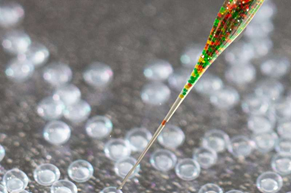
Source: https://phys.org/news/2021-08-crispr-based-technology-identification-genes-involved.html
Eco-friendly plastic from cellulose and water
July 22, 2021
Summary:
Plastics offer many benefits to society and are widely used in our daily life: they are lightweight, cheap and adaptable. However, the production, processing and disposal of plastics pose a major global threat to the environment and human health. Researchers from University of Göttingen have now found a sustainable method - 'hydrosetting', which uses water at normal conditions - to process and reshape a new type of hydroplastic polymer.
More-https://www.sciencedaily.com/releases/2021/07/210722131348.htm
Researcher introduces new CRISPR 3.0 system for highly efficient gene activation in plants
JUN 24, 2021
Summary:
In a study in Nature Plants, Yiping Qi, associate professor of Plant Science at the University of Maryland (UMD), introduces a new and improved CRISPR 3.0 system in plants, focusing on gene activation instead of traditional gene editing. This third generation CRISPR system focuses on multiplexed gene activation, meaning that it can boost the function of multiple genes simultaneously. According to the researchers, this system boasts four to six times the activation capacity of current state-of-the-art CRISPR technology, demonstrating high accuracy and efficiency in up to seven genes at once. While CRISPR is more often known for its gene editing capabilities that can knock out genes that are undesirable, activating genes to gain functionality is essential to creating better plants and crops for the future.
More- https://phys.org/news/2021-06-crispr-highly-efficient-gene.html
Bio-sensor detects early signs of plant stress to prevent climate-related crop failure
MAY 25, 2021
Summary:
A team of researchers from the Hebrew University of Jerusalem (HU)'s Robert H. Smith Faculty of Agriculture, Food and Environment developed a method to detect signs of stress before the plant is damaged.
Rosenwaser explained "By using a fluorescent camera with extremely high sensitivity, we were able to monitor the fluorescence signals emitted from the biosensors and noticed the accumulation of reactive oxygen species during the early phase responses to stress conditions such as drought, extreme temperature, and high light,"
More-https://phys.org/news/2021-05-bio-sensor-early-stress-climate-related-crop.html
New method of artificially creating genetic switches for yeast
April 14, 2021
Summary
A group of researchers from Kobe University and Chiba University has successfully developed a flexible and simple method of artificially producing genetic switches for yeast, a model eukaryotic organism. Genetic switches are necessary in order to artificially generate new functions in an organism. The researchers established a platform for creating genetic switches that could be applied to the development of sophisticated, artificially controlled yeast cells to produce large quantities of valuable compounds.
More-https://www.sciencedaily.com/releases/2021/04/210414132012.htm
Scientists set a path for field trials of gene drive organisms
DECEMBER 17, 2020
The modern rise of gene drive research, accelerated by CRISPR-Cas9 gene editing technology, has led to transformational waves rippling across science.
Gene drive organisms (GDOs), developed with select traits that are genetically engineered to spread through a population, have the power to dramatically alter the way society develops solutions to a range of daunting health and environmental challenges, from controlling dengue fever and malaria to protecting crops against plant pests.
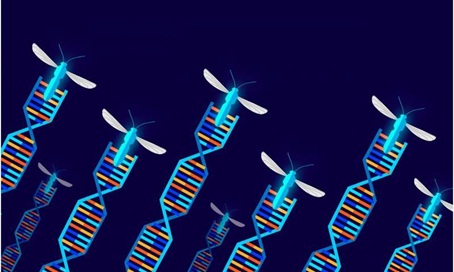
Source:https://phys.org/news/2020-12-scientists-path-field-trials-gene.html
Scientists breed new rice variety with ion beam technology
DECEMBER 15, 2020
A research team led by Prof. WU Yuejin from the Institute of Intelligent Machines of the Hefei Institutes of Physical Science (HFIPS) bred a rice variety with ion beam breeding technology.
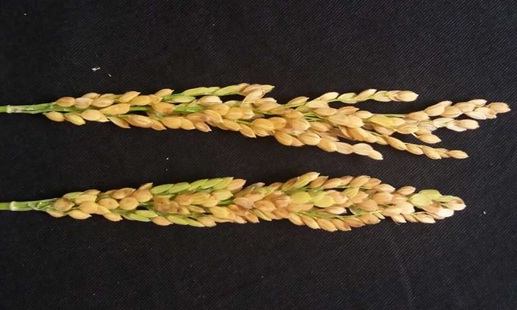
Source: https://phys.org/news/2020-12-scientists-rice-variety-ion-technology.html
Biochar from agricultural waste products can adsorb contaminants in wastewater
November 16, 2020
Biochar -- a charcoal-like substance made primarily from agricultural waste products -- holds promise for removing emerging contaminants such as pharmaceuticals from treated wastewater. That's the conclusion of a team of researchers that conducted a novel study that evaluated and compared the ability of biochar derived from two common leftover agricultural materials -- cotton gin waste and guayule bagasse -- to adsorb three common pharmaceutical compounds from an aqueous solution.
Source:https://www.sciencedaily.com/releases/2020/11/201116161228.htm
Artificial cyanobacterial biofilm can sustain green ethylene production for over a month
Date: October 15, 2020
Ethylene is one of the most important and widely used organic chemicals. A research group from University of Turku has designed a thin-layer artificial biofilm with embedded cyanobacterial cell factories which were specifically engineered for photosynthetic production of 'green' ethylene. The fabricated biofilms have sustained ethylene production for up to 40 days.
Source: https://www.sciencedaily.com/releases/2020/10/201015101801.htm
E. coli engineered to grow on CO2 and formic acid as sole carbon sources
Date: September 29, 2020
The Korea Advanced Institute of Science and Technology (KAIST) research group has developed a strategy to grow an E. coli strain to higher cell density solely on CO2 and formic acid. Formic acid is a one carbon carboxylic acid, and can be easily produced from CO2 using a variety of methods.
Most biorefinery processes have relied on the use of biomass as a raw material for the production of chemicals and materials. Even though the use of CO2 as a carbon source in biorefineries is desirable, it has not been possible to make common microbial strains such as E. coli grow on CO2.
Source: https://www.sciencedaily.com/releases/2020/09/200929123619.htm
3. Cyanobacteria: Small candidates as great hopes for medicine and biotechnology
An ever-growing global population, an increasing standard of living and environmental challenges such as anthropogenic climate change, ocean pollution, the declining availability of arable land and dwindling fossil resources—these are today's global challenges. Therefore, the German Federal Ministry of Education and Research has dedicated the Science Year 2020/21 to the topic Bioeconomy with the aim of meeting these challenges with little heroes. The 'stars' of bioeconomy are proteins, algae, microorganisms, and other tiny creatures with great impact.
At the Chair of Technical Biochemistry at TU Dresden, the researchers will now focus on some of the oldest of such little superheroes: cyanobacteria. There are about 2000 species of cyanobacteria and many of these species have been poorly researched. Dr. Paul D'Agostino, Professor Tobias Gulder and their team—including cooperation partners Michelle Gehringer (TU Kaiserslautern), Michael Lakatos and Patrick Jung (both Hochschule Kaiserslautern) – hope that unusual cyanobacteria will yield promising results and make an innovative contribution to bioeconomy.
"Microorganisms produce valuable organic molecules with great potential for many applications. It is important to know that unusual organisms often also produce novel bioactive agents. The discovery of such new, bioactive molecules is essential if one thinks, for example, of new medical challenges such as the coronavirus and the progressive development of resistance to established active agents. Within the scope of this project, we therefore want to investigate the genetic potential of very unusual cyanobacteria for the production of innovative active pharmaceutical ingredients," explains Gulder.
As a first step, the team will predict the potential of natural compounds by sequencing the genomes and subsequent bioinformatic analysis. The results can then be translated into the targeted discovery of new molecules using modern methods of synthetic biology and biotechnology. As a final step, the project will focus on the production and characterization of these natural compounds and on the application of the enzymes producing these compounds as biocatalysts for the development of sustainable chemical processes.
https://phys.org/news/2020-10-cyanobacteria-small-candidates-great-medicine.html

Padma Shri Prof. Ananda M. Chakrabarty
It is with deep sorrow that Padma Shri Prof. Ananda M. Chakrabarty is no more. He passed away on 10 July 2020 (aged 82) in Illinois, USA. It is a great loss to the scientific world. He - was a Bengali American microbiologist, scientist, and researcher, most notable for his work in directed evolution and his role in developing a genetically engineered organism using plasmid transfer while working at GE. Prof. Chakrabarty genetically engineered a new species of Pseudomonas bacteria (”the oil-eating bacteria”). He was involved in research and development of promiscuous bacterial protein/peptide drugs with anticancer, anti-viral and anti-parasitic activities.
Microorganisms help production
Date: November 13, 2018
Karlsruher Institut für Technologie (KIT) Researchers are focusing on plant biomass such as wood and straw which is not used as food or feed. Oil is still the most economically attractive resource for fuels and basic chemicals that can be used to manufacture everyday products such as plastic bottles and detergent. New biotechnological processes aim to simplify the use of renewable biomass as an alternative to the fossil raw material and make it more cost-effective.
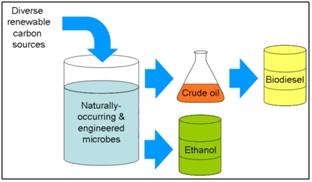
Source https://www.altenergymag.com
Source: https://www.sciencedaily.com/releases/2018/11/181113110319.htm
Electrochemical techniques for monitoring microbial growth demonstrated
Date: December 4, 2018
Microorganisms are used in many industrial applications, including production of fuels, chemicals, pharmaceuticals, and foods (e.g., ethanol, acetate, biodegradable plastics, penicillin, and yogurt). Like all organisms, microorganisms use food sources such as sugars, proteins, and lipids to obtain organic carbon for growth as well as energy from electrons released during break-down of food sources.
Savannah River National Laboratory, in collaboration with Clemson University, the University of South Carolina and Savannah River Consulting LLC, has demonstrated the use of electrochemical techniques to monitor the growth status and energy levels of microorganisms used in biotechnology industries.
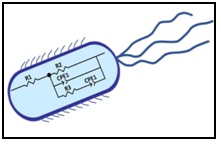
Electrochemical techniques are being used to define microorganisms as electrochemical entities and thereby provide opportunities to monitor microbial activity in real time, in-situ.
Source: https://www.sciencedaily.com/releases/2018/12/181204090333.htm
Technique identifies electricity-producing bacteria
Microbes screened with a new microfluidic process might be used in power generation or environmental cleanup
Date: January 11, 2019
Massachusetts Institute of Technology Engineers have developed a microfluidic technique that can quickly process small samples of bacteria and gauge a specific property that's highly correlated with bacteria's ability to produce electricity. They say that this property, known as polarizability, can be used to assess a bacteria's electrochemical activity in a safer, more efficient manner compared to current techniques.
A microfluidic technique quickly sorts bacteria based on their capability to generate electricity.
Source: https://www.sciencedaily.com/releases/2019/01/190111143740.htm
Research identifies mechanism that helps plants fight bacterial infection
Study could lead to better strategies for protecting crops from attacks by pathogens
Date: February 28, 2019
A team led by a plant pathologist at the University of California, Riverside, has identified a regulatory, genetic mechanism in plants that could help fight bacterial infection.
Working on Arabidopsis thaliana, a small flowering plant widely used by biologists as a model species, Jin's research team found that Argonaute protein, a major core protein in the RNA interference machinery, is controlled by a process called "post-translational modification" during bacterial infection.
This process controls the level of the Argonaute protein and its associated small RNAs -- molecules that regulate biological processes by interfering with gene expression. This provides double security in regulating the RNA interference machinery. RNA interference, or RNAi, is an important cellular mechanism that many organisms use to regulate gene expression. It involves turning off genes, also known as "gene silencing."
Source: https://www.sciencedaily.com/releases/2019/02/190228154849.htm
Using E. coli to create byproducts, like biodiesel, in a cost-effective manner
Date: February 21, 2019
LSU Mechanical Engineering graduate student Tatiana Mello of Piracicaba, Brazil, is currently working on genetically engineering and optimizing E. coli bacteria to produce bioproducts, like biodiesel, in a cost-effective manner. Mello proposes using E. coli bacteria to expand biodiesel production by creating a new type of feedstock.
"The main feedstocks used in the U.S. for biodiesel are soybean and corn oil," . "The actual production is enough to feed us, but you have the surplus that nobody knew what to do with, so biodiesel was created. They expect within a few decades, the surplus won't be enough to produce biodiesel. E. coli is cheap and abundant, and you can just genetically modify it to fulfill this need."
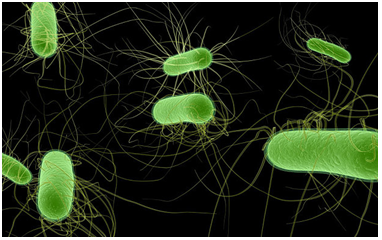
E Coli Bacteria produce propane.
https://www.sciencedaily.com/releases/2019/02/190221130305.htm
Commandeering microbes pave way for synthetic biology in military environments
Date: October 2, 2018
A team of scientists from the U.S. Army Research Laboratory and the Massachusetts Institute of Technology have developed and demonstrated a pioneering synthetic biology tool to deliver DNA programming into a broad range of bacteria.

More: https://www.sciencedaily.com/releases/2018/10/181002102803.htm
How some algae may survive climate change
September 28, 2018, Rutgers University
Green algae that evolved to tolerate hostile and fluctuating conditions in salt marshes and inland salt flats are expected to survive climate change, thanks to hardy genes they stole from bacteria, according to a Rutgers-led study.
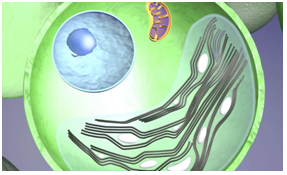
More at: https://phys.org/news/2018-09-algae-survive-climate.html#jCp
Scientists identify enzyme that could accelerate biofuel production
August 20, 2018, Tokyo Institute of Technology
Researchers at the Tokyo Institute of Technology report on an enzyme belonging to the glycerol-3-phosphate acyltransferase (GPAT) family as a promising target for increasing biofuel production from the red alga Cyanidioschyzon merolae.
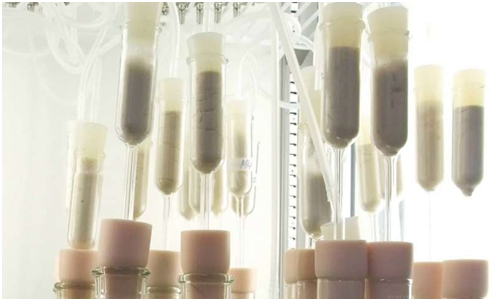
The red alga C. merolae grown in culture in the laboratory
More: https://phys.org/news/2018-08-scientists-enzyme-biofuel-production.html
Researchers engineer bacteria to create fertilizer out of thin air
July 16, 2018, Washington University in St. Louis
The research, led by Himadri Pakrasi, the Glassberg-Greensfelder Distinguished University Professor in the Department of Biology in Arts & Sciences and director of the International Center for Energy, Environment and Sustainability (InCEES); and Maitrayee Bhattacharyya-Pakrasi, senior research associate in biology, was published in the May/June issue of mBio.
Creating fertilizer is energy intensive, and the process produces greenhouse gases that are a major driver of climate change. And it's inefficient. Fertilizing is a delivery system for nitrogen,
More: https://phys.org/news/2018-07-bacteria-fertilizer-thin-air.html
Researchers discover key for converting waste to electricity
March 3, 2008
Researchers at the University of Minnesota studying bacteria capable of generating electricity have discovered that riboflavin (commonly known as vitamin B-2) is responsible for much of the energy produced by these organisms.
The bacteria, Shewanella, are commonly found in water and soil and are of interest because they can convert simple organic compounds (such as lactic acid) into electricity, according to Daniel Bond and Jeffrey Gralnick, of the University of Minnesota’s BioTechnology Institute and department of microbiology, who led the research effort.
More: https://phys.org/news/2008-03-key-electricity.html#nRlv
Plastic made from plants may solve waste problem
The Times of India, Kolkata March 1, 2018
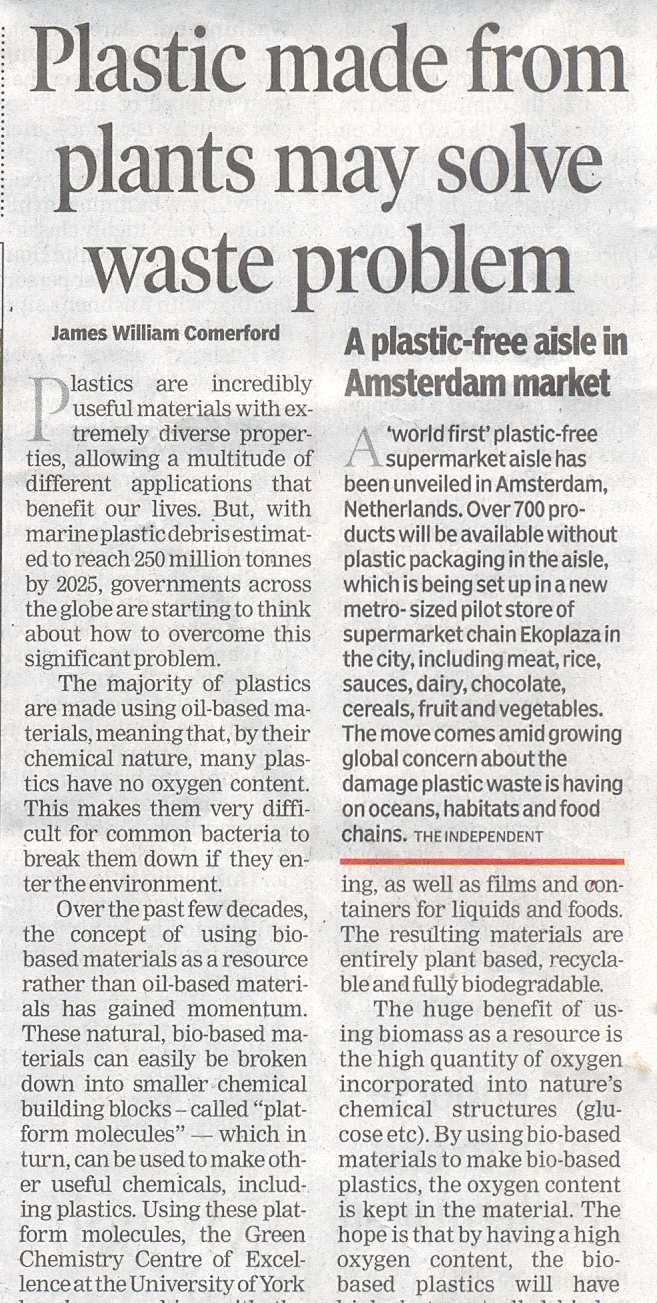
Certain bacteria produce tiny gold nuggets by digesting toxic metals
Date:January 31, 2018
A team of researchers from Martin Luther University Halle-Wittenberg (MLU), the Technical University of Munich (TUM) and the University of Adelaide in Australia has discovered that high concentrations of heavy metals, like copper and gold, are toxic for most living creatures. This is not the case for the bacterium C. metallidurans, which has found a way to extract valuable trace elements from a compound of heavy metals without poisoning itself. One interesting side-effect: the formation of tiny gold nuggets.The molecular processes that take place inside the bacteria. The group presented their findings in the journal Metallomicspublished by the Royal Society of Chemistry.
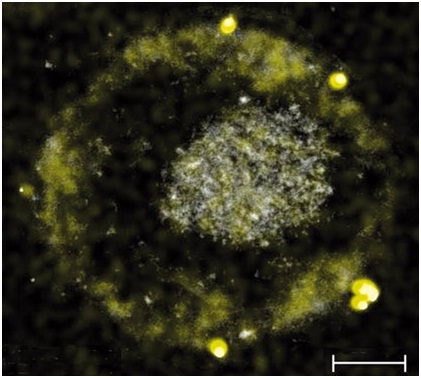
C. metallidurans can produce small gold nuggets.
SOURCE:https://www.sciencedaily.com/releases/2018/01/180131095453.htm
Major threats to soil ecosystems from a combination of invasive species and climate change December 19, 2017, Monash University
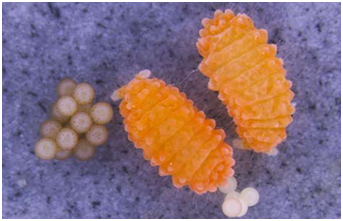
Springtails, such as this neanurid species, play a key role in terrestrial ecosystems. Credit: ChownLab, Monash University
A study published this week in Proceedings of the National Academy of Sciences by a Monash University team shows that a new threat faces soil sustainability everywhere.
Proceedings of the National Academy of Sciences by a Monash University team found that, from the polar regions to the tropics, invasive soil-dwelling species are typically better able to cope with warming than their indigenous counterparts. Climate change will benefit invasive species, suggesting major changes to the functioning of ecosystems, and potentially bad news for the United Nation's Sustainable Development Goals of conserving and restoring terrestrial ecosystems (SDG 15: Life on Land), and ending hunger and malnutrition (SDG 2: Zero Hunger).
The work was conducted on springtails – small soil invertebrates that are globally ubiquitous, and influence both soils and the aboveground ecosystems which rely on them. Together with other invertebrates, such as earthworms, these animals make soil ecosystems work.
As with earthworms, humans have moved springtail species unintentionally around the world from their natural homes to new environments. What the study shows is that these alien species are much more tolerant of high temperatures than their indigenous relatives.

An Isotomurus springtail species. Alien species like these have, on average, greater resistance to high temperatures than their indigenous counterparts. Credit: ChownLab, Monash University
"The impacts of soil invasives are becoming increasingly well known" said Dr. Charlene Janion-Scheepers, lead author, "What we have found is that alien invasive species will thrive under climate change, much more so on average than local species, irrespective of where one looks".
More at: https://phys.org/news/2017-12-major-threats-soil-ecosystems-combination.html#jCp
Virus stamping—a versatile new method for genetic engineering of single cells
December 19, 2017, Friedrich Miescher Institute for Biomedical Research
Research groups led by Botond Roska at the Friedrich Miescher Institute for Biomedical Research (FMI) and Daniel Müller at the ETH Zurich Department of Biosystems Science and Engineering (D BSSE) have developed a novel method that allows them to efficiently deliver genes into single cells in whole tissues. This not only facilitates the study of the individual cells in an organ such as the brain, but could also pave the way to new gene therapies.
For decades now, scientists have used viruses as vehicles for introducing new genes into cells. Different types of viruses such as lentivirus, herpes simplex and adeno-associated viruses can be used to genetically engineer individual cells or cellular assemblies. However, existing methods have major drawbacks, which limit their application both in basic research and in gene therapeutic approaches. As Botond Roska, Senior group leader at the FMI, points out: "Recently developed methods to target individual cells opened exciting possibilities, but unfortunately their applicability in tissues is limited or they are technically very complex."
More: https://phys.org/news/2017-12-virus-stampinga-versatile-method-genetic.html
RNA discovery could help boost plant heat, drought tolerance
Date: September 18, 2017
Source: Texas A&M AgriLife Communications
Summary:
Texas A&M AgriLife Research scientists have discovered a ribonucleic acid, or RNA, that can increase the thale cress plant's resistance to stress from drought and salt. The discovery could help illuminate a new pathway to engineering drought- and salt-tolerant plants, including food crops, said Dr. Liming Xiong, AgriLife Research associate professor, Dallas. "This is the first finding of a long non-coding RNA, or lncRNA, that regulates plant tolerance to adverse, non-physiological external factors," Xiong said.
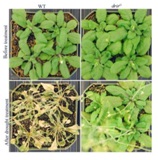
A side-by-side comparison shows better heat and drought tolerance in thale cress plants whose level of a specific RNA was increased.
More: https://www.sciencedaily.com/releases/2017/09/170918123552.htm
Driving drug resistance out of fungi
New gene drive targeting a fungal pathogen enables identification of virulence regulators and potential future combination therapies
Date: October 30, 2017
Source: Wyss Institute for Biologically Inspired Engineering at Harvard
Summary: Scientists have developed a CRISPR-Cas9-based 'gene drive' platform to create diploid strains of the pathogen in which both gene copies could be efficiently deleted. The technique may lead the way toward a better understanding of drug resistance and biofilm-forming mechanisms, and through future research, it could help pinpoint new drug targets and combination therapies
https://www.sciencedaily.com/releases/2017/10/171030084731.htm
Mushrooms are full of antioxidants that may have antiaging potential
Date: November 9, 2017
Source: Penn State
Summary: According to a team of Penn State researchers Mushrooms may contain unusually high amounts of two antioxidants that some scientists suggest could help fight aging and bolster health.
In a study, researchers found that mushrooms have high amounts of the ergothioneine and glutathione, both important antioxidants, said Robert Beelman, professor emeritus of food science and director of the Penn State Center for Plant and Mushroom Products for Health. He added that the researchers also found that the amounts the two compounds varied greatly between mushroom species.
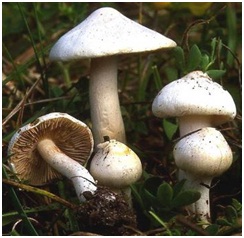
More: https://www.sciencedaily.com/releases/2017/11/171109100409.htm
Biotechnology researchers turn to landfill sites
August 22, 2017
A new research paper in mSphere by biologists at Bangor and Liverpool universities has for the first time identified the enzymes which degrade natural materials such as paper and clothing in landfill sites.
"There is a current impetus to search for new enzymes to improve biomass conversion processes. Our hypothesis is that, due to the volume of waste materials they hold, landfill sites represent a repository of unexplored biomass-degrading diversity. There is significant potential to identify new enzymes of ecological and biological significance."
Cellulose and lignin occur naturally in plant-based materials and take longer to decompose than other waste products. As a result of this, the majority of landfill waste consists of lignin and cellulose. In their plant form, they can be used as the basis for biofuel production, and identifying more effective enzymes for this process would improve the yield from this source.
"Understanding exactly how the cellulose and lignin decompose, and the sources of the active enzymes in the process will enable us to determine ways to improve the degradation of waste in landfill sites, and potentially use this as a source for biofuel production."
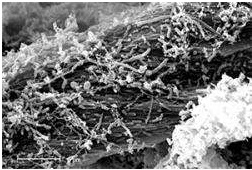
Read more at: https://phys.org/news/2017-08-biotechnology-landfill-sites.html#jCp
Evolution of a bacterial enzyme in green algae
July 12, 2017
A new jigsaw piece in the evolution of green algae has been identified by researchers at Ruhr-Universität Bochum together with colleagues from Max Planck Institute in Mülheim an der Ruhr. They analysed the hydrogen-producing enzyme of a phylogenetically old alga. Its properties were radically different from those of analogous enzymes in more recent algae. The phylogenetically old alga Chlorella variabilis has likewise the ability for light-driven generation of hydrogen. The researchers from Bochum and Mülheim isolated and characterised the Chlorella hydrogenase. Algae which are relatively young in evolutionary terms contain specialised hydrogenases that show significant differences to the original varieties in bacteria. They are smaller and have a specific surface used for docking to the cell's photosynthesis machinery. To this end, they bind to ferredoxin, a molecule that mediates electron transfer. Thus, they are able to produce hydrogen using light energy.
Source: https://phys.org/news/2017-07-evolution-bacterial-enzyme-green-algae.html#jCp
Genetic engineering tool generates antioxidant-rich purple rice
Qinlong Zhu of the South China Agricultural University have developed a genetic engineering approach capable of delivering many genes at once and used it to make rice endosperm—seed tissue that provides nutrients to the developing plant embryo—produce high levels of antioxidant-boosting pigments called anthocyanins. The resulting purple endosperm rice holds potential for decreasing the risk of certain cancers, cardiovascular disease, diabetes, and other chronic disorders.
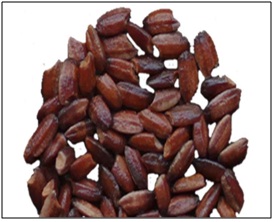
A photograph of purple endosperm rice
Source: https://phys.org/news/2017-06-genetic-tool-antioxidant-rich-purple-rice.html
Four strains of bacteria work together to produce pigment for food and cosmetics industry
Researchers at Rensselaer Polytechnic Institute have shown that four strains of E. coli bacteria working together can convert sugar into the natural red anthocyanin pigment found in strawberries, opening the door to economical natural colors for industrial applications. The research marks the first biosynthesis method using four strains of bacteria to manufacture a compound in a single step, said Mattheos Koffas, a professor of chemical and biological engineering at Rensselaer, and member of the Center for Biotechnology and Interdisciplinary Studies.
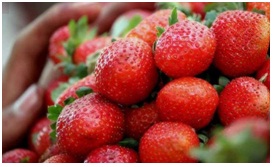
Source: https://phys.org/news/2017-06-strains-bacteria-pigment-food-cosmetics.html
Genome sequence of fuel-producing alga announced
Date: May 10, 2017
The genome of the fuel-producing green microalga Botryococcus braunii has been sequenced by a team of researchers led by a group at Texas A&M AgriLife Research.In addition to sequencing the genome, other genetic facts emerged that ultimately could help his team and others studying this green microalga further research toward producing algae and plants as a renewable fuel source.
https://www.sciencedaily.com/releases/2017/05/170510174850.htm
Engineers design 'tree-on-a-chip': Microfluidic device generates passive hydraulic power
March 20, 2017 by Jennifer Chu
Now engineers at MIT and their collaborators have designed a microfluidic device they call a "tree-on-a-chip," which mimics the pumping mechanism of trees and plants. Like its natural counterparts, the chip operates passively, requiring no moving parts or external pumps. It is able to pump water and sugars through the chip at a steady flow rate for several days.
Trees and other plants, from towering redwoods to diminutive daisies, are nature's hydraulic pumps. They are constantly pulling water up from their roots to the topmost leaves, and pumping sugars produced by their leaves back down to the roots. This constant stream of nutrients is shuttled through a system of tissues called xylem and phloem, which are packed together in woody, parallel conduits. The results are published this week in Nature Plants.
More: https://phys.org/news/2017-03-tree-on-a-chip-microfluidic-device-passive-hydraulic.html
Chemical engineers program yeast to convert plant sugars into oils
January 17, 2017
The researchers, led by Gregory Stephanopoulos, the Willard Henry Dow Professor of Chemical Engineering and Biotechnology at MIT, engineers have genetically reprogrammed a strain of yeast so that it converts sugars to fats much more efficiently, an advance that could make possible the renewable production of high-energy fuels such as diesel. Modified the metabolic pathways of yeast that naturally produce large quantities of lipids, to make them about 30 percent more efficient.
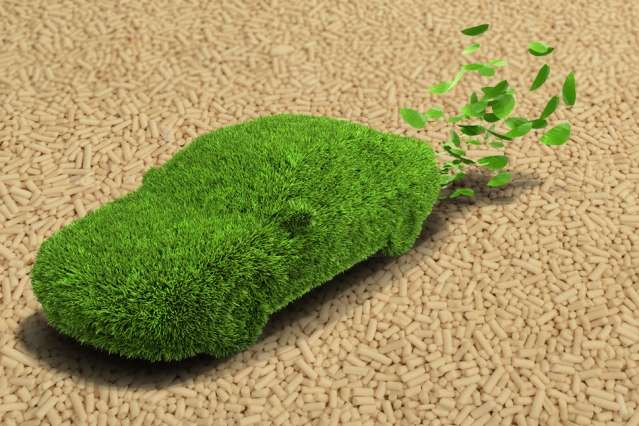
Source: https://phys.org/news/2017-01-chemical-yeast-sugars-oils.html
Scientists just found a new way to farm biofuel-producing algae, and it's 10x faster than before
February 1, 2017
Research from Syracuse University biomedical and chemical engineering PhD candidate Bendy Estime suggests a new method may be on the horizon. The dream of using microalgae as an alternative biofuel is great, but it comes with challenges. “This research proposes an energy efficient way to grow and harvest microalgae,” Estime told Digital Trends. “By allowing microalgae to grow in a confined environment, mixing cost can be avoided and the distribution and absorption of light can better be controlled. The simplification of the microalgal biomass harvesting process makes this technology even more outstanding.”

Source: http://www.digitaltrends.com/cool-tech/farming-microalgae-biofuel/
Bioenergy grass can withstand freezing temperatures
Date: November 29, 2016
Summary: Prairie cordgrass, , Spartina pectinata, a native perennial grass used for biomass energy, is tolerant to salt, flooding, and freezing stress. Being tolerant of environmental stress factors is important for biomass crops, because they are often grown on so-called marginal land where conditions are far from perfect. With its tolerance of several major stress factors, cordgrass has the potential to be grown in more places than other perennial energy crops. A new study demonstrates the gene expression patterns responsible for freezing tolerance in prairie cordgrass. Once the genes responsible for freezing tolerance are identified in prairie cordgrass, they may be applied to other crops in the future.
More:https://www.sciencedaily.com/releases/2016/11/161129133631.htm
New grasses neutralize toxic pollution from bombs, explosives, and munitions
Date: November 22, 2016

University of Washington engineers and colleagues have developed transgenic grass species that can eliminate RDX, a toxic compound widely used in explosives that contaminates military bases, battlegrounds and some drinking water wells.
UW engineers introduced two genes from bacteria that learned to eat RDX and break it down into harmless components in two perennial grass species: switchgrass (Panicum virgatum) and creeping bentgrass (Agrostis stolonifera). The best-performing strains removed all the RDX from a simulated soil in which they were grown within less than two weeks, and they retained none of the toxic chemical in their leaves or stems.
More: https://www.sciencedaily.com/releases/2016/11/161122182355.htm
New genetically modified variety of cotton disables sap sucking whiteflies
September 13, 2016
A team of researchers from a multitude of institutions in India has developed a genetically modified cotton variety that stunts the growth of sap sucking whiteflies, reducing their negative impact on crop yields.
The team began by looking at ferns which are known to be nearly immune to attack by whiteflies. They found that the protein responsible for providing such protection was Tectaria macrodonta, which they promptly shortened to Tma12. Next, they genetically modified a group of cotton plants causing them to produce the protein. They inserted the genes into 87 genetic locations of which just 16 plants grew to maturity—of those, just nine produced a reasonable amount of the desired protein. The researchers found that the whiteflies who fed on the modified plants experienced abnormal development similar to those that fed on the original ferns and very few lasted long as adults. They also found that the modified plants did not cause problems for other insects, which meant they appeared to be safe for use in the wild.
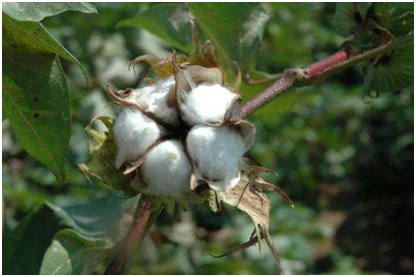
Fig: A cotton boll grown in the field
Source: http://phys.org/news/2016-09-genetically-variety-cotton-disables-sapsucking.html#jCp
Genetically modified soil bacteria work as electrical wires
August 16, 2016
Scientists sponsored by the Office of Naval Research (ONR) have genetically engineered a new strain of bacteria, found naturally in dirt, to create electrical wires that not only conduct electricity, but also rival the thinnest wires known to humanity. The nanowires could have a great impact on the future force, contributing to everything from smaller electronic devices to alternative fuels. The ONR-sponsored researchers -- say their engineered wires can be produced using renewable "green" energy resources like solar energy, carbon dioxide or plant waste; are made of non-toxic, natural proteins; and avoid harsh chemical processes typically used to create nanoelectronic materials.
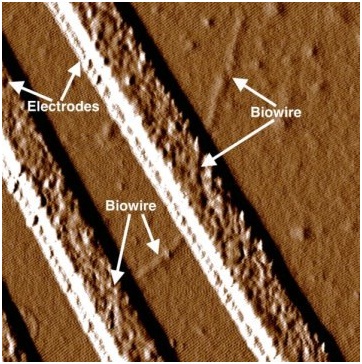
Fig: Nanowires developed by the Scientists sponsored by the Office of Naval Research (ONR)
More: https://www.sciencedaily.com/releases/2016/08/160816182622.htm
Engineering E. coli for biofuel, bioproduct production
July 7, 2016
 Researchers developed an alternative fatty acid synthase (FAS) system in which enzymes from other organisms work with the native FAS in E. coli to improve the microbe’s capacity for chemical production. Researchers developed an alternative fatty acid synthase (FAS) system in which enzymes from other organisms work with the native FAS in E. coli to improve the microbe’s capacity for chemical production.
Researchers developed an alternative fatty acid synthase (FAS) system in which enzymes from other organisms work with the native FAS in E. coli to improve the microbe’s capacity for chemical production. Researchers developed an alternative fatty acid synthase (FAS) system in which enzymes from other organisms work with the native FAS in E. coli to improve the microbe’s capacity for chemical production.
Valuable chemicals and fuels have been produced in engineered strains of Escherichia coli by deregulating this organism's fatty acid synthase (FAS), causing the microorganism to pump out chemicals. For example, E. coli produces chemicals used to manufacture detergents and lubricants as well as methyl ketones that have promising fuel properties. Previous microbial production methods have been based on highly regulated enzymatic processes that can limit yield. Researchers developed an alternative FAS system in which enzymes from other organisms work with the native FAS in E. coli to improve the microbe's capacity for chemical production.
https://www.sciencedaily.com/releases/2016/07/160707120503.htm
Microalgae: Promising future resource?
July 13, 2016

Microalgae hold tremendous potential for industrial biotechnology. They are an important resource in the production of food and medications, and in many other applications. In comparison to bacteria and fungi, however, they still play only a minor role. The economic use of these organisms has been difficult in the past primarily because existing production procedures are too costly. The algae specialist Professor Michael Melkonian and his team from the University of Cologne have now developed a new method that could make the production of algae easier -- and hence reduce the costs of the products based on this material. New technological developments allow for a significant decrease in the resources necessary for microalgae production. This could lead to an increase in the use of microalgae in a wide range of applications -- from food production to medical applications and nutrient recovery.
https://www.sciencedaily.com/releases/2016/07/160713101617.htm
Genetically improving sorghum for production of biofuel
July 13, 2016
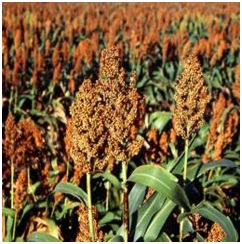
The bioenergy crop sorghum holds great promise as a raw material for making environmentally friendly fuels and chemicals that offer alternatives to petroleum-based products. Sorghum can potentially yield more energy per area of land than other crops while requiring much less input in terms of fertilizer or chemicals. New research examines how genetic improvement of specific sorghum traits, with an eye toward sustainability, could help maximize the usefulness of sorghum as a bioenergy crop.
The bioenergy crop sorghum holds great promise as a raw material for making environmentally friendly fuels and chemicals that offer alternatives to petroleum-based products. Sorghum can potentially yield more energy per area of land than other crops while requiring much less input in terms of fertilizer or chemicals. New research examines how genetic improvement of specific sorghum traits, with an eye toward sustainability, could help maximize the usefulness of sorghum as a bioenergy crop.
https://www.sciencedaily.com/releases/2016/07/160713100851.htm
Modified microalgae converts sunlight into valuable medicine
Date:May 20, 2016
A special type of microalgae will soon produce valuable chemicals such as cancer treatment drugs and much more just by harnessing energy from the sun, suggest researchers. Researchers from Copenhagen Plant Science Centre at University of Copenhagen have succeeded in manipulating a strain of microalgae to form complex molecules to an unprecedented extent. This may pave the way for an efficient, inexpensive and environmentally friendly method of producing a variety of chemicals, such as pharmaceutical compounds.
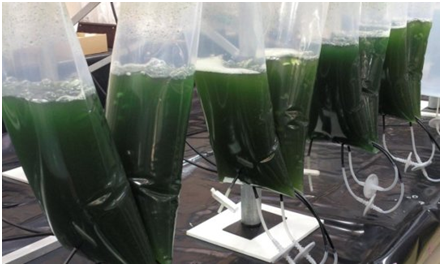
The microalgae cultures are able to grow rapidly using waste water and light.
Source:https://www.sciencedaily.com/releases/2016/05/160520110406.htm
A path away from reliance on oil, with the help of bacteria
Date: May 19, 2016
Adding genes to bacteria offers sustainable routes to make compounds currently obtained from petrochemicals. The dream of replacing petrochemicals with renewable resources in the manufacture of synthetic fibers and plastics has moved a step closer. Researchers at Agency for Science, Technology and Research (A*STAR), Singapore, have genetically modified the bacterium Escherichia coli to produce a compound that can be converted into a base material for manufacturing nylon and other synthetic products.

Biomass such as this waste from palm oil production could replace petrochemicals for making nylon.
Source: https://www.sciencedaily.com/releases/2016/05/160519140828.htm
Genetic Engineering in Deinococcus Radiodurans
Scientists transferred a set of genes from Pseudomonas into Deinococcus radiodurans that encode an enzyme that partially breaks down toluene and other toxic chemicals. This was accomplished by fusing a gene encoding toluene dioxygenase, which is an enzyme that degrades toluene, to a Deinococcus radiodurans promoter (a site that activates the gene). Then the DNA was inserted into one of the bacterium's chromosomes, which ultimately resulted in a recombinant bacterium. The end result gives you a bacterium that is capable of degrading toluene and other organic compounds in a high-radiation environment. This genetically engineered bacterium can withstand toluene and trichloroethylene at levels that exceeds the levels found at many radioactive waste sites. Even after the D. radiodurans has been exposed to radiation, it is still able produce this valuable enzyme. This is important because the "bug" is able to do its job in a highly radioactive site.
Brief report on participation in National Evaluation Workshop for ENVIS Centres (17th – 19th February, 2016) at New Delhi
ENVIS centre on Environmental Biotechnology of Kalyani University participated in National Evaluation Workshop. In the Inaugural session, our Centre launched three mobile apps in presence of Honourable Minister of State (Environment), Government of India,
Shri Prakash Javadekar. In addition Smt. Anandi Subramanian, Sr. Advisor, GOI, ENVIS Secretariat, MOEF&CC also released the newsletter Volume 27 in this session
Prof. S.C.Santra, Coordinator and Shri Sourav Banerjee, IT Assistant represent the centre in the workshop.
More: National Evaluation Workshop for ENVIS Centres
Sensing the future of molecule detection, bioproduction
Date:January 28, 2016
A team of researchers at the Wyss Institute for Biologically Inspired Engineering at Harvard University and Harvard Medical School (HMS) led by George Church, Ph.D., has developed a new method for engineering a broad range of biosensors to detect and signal virtually any desired molecule using living eukaryotic cells. Synthetically engineered biosensors, which can be designed to detect and signal the presence of specific small molecule compounds, have already unlocked many potential applications by harnessing bacterial cells such as E. coli to sense toxins or enable bioproduction of valuable commodities including fuel, plastics, and pharmaceuticals. As of yet, however, scientists have been challenged to leverage biosensors for use in eukaryotic cells -- which comprise yeast, plants and animals -- because strategies-to-date are limited in the molecules they can detect and the signals they can produce.
More: http://www.sciencedaily.com/releases/2016/01/160128113833.htm
Display of ENVIS Publications in 40th Kolkata Book Fair, held at Kolkata from January 26th, – 7th February, 2016.
The ENVIS centre participated in Kolkata (International) Book Fair for displaying the publications of centre in Kalyani University Stall (No-274), during the above period. A snap short of exhibition gallery is shown below.
Display of ENVIS Activities at Barrackpore Rly Station during exhibition on Science Express Climate Action Special (SECAC) from 18-21 January, 2016.
The Centre participated in the exhibition of Science Express Climate Action Special (SECAC), held at Barrackpore Rly Station, West Bengal from 18-21 January, 2016. During the visit of Science Express Climate Action Special (SECAC) we have displayed activities of our ENVIS centre to the school children, research students, NGOs and academicians those visited our stall. We demonstrate our centre’s activity and also distributed the new letter/handout and books etc.
INDO-US WORKSHOP ON CELL FACTORIES, IIT BOMBAY, MUMBAI, INDIA
18-20 MARCH 2016
Venue: VMCC auditorium on the IIT campus
Website: http://www.che.iitb.ac.in/cellfactories/
Fungi may help drought-stressed wheat
December 17, 2015 by Janne Hansen
Scientists from the Department of Agroecology at Aarhus University have recently discovered that fungi associated with plant roots may improve growth and yield of drought-stressed wheat.
A specific group of useful fungi - the so-called arbuscular mycorrhizal fungi (AM fungi)—may be able to help alleviate drought stress in wheat. These fungi live in a symbiotic relationship with plant roots. This symbiotic relationship involves a mutual exchange of nutrients between the crop and the fungus. The fungus provides inorganic nutrients, in particular phosphorus, to the plant. Furthermore, the fungi help crops fight biotic stress factors such as diseases and pests.
Source: http://phys.org/news/2015-12-fungi-drought-stressed-wheat.html
Scientist's research shows promise in creating sustainable algae-based biofuels
December 15, 2015 by Karen B. Roberts
UD scientist Jennifer Stewart and her research team are working to create sustainable algae-based biofuels that can also reduce carbon dioxide and other harmful emissions in the atmosphere. Scientists have long sought to find clean, green alternatives to fossil fuels like gasoline, which exacerbate the carbon dioxide problem, and biofuels—fuels derived from biological resources such as plants or plant biomass—are considered a renewable solution.
But using algae to produce biofuels hasn't been all that easy—or cheap.
Growing algae at commercial scales requires more carbon dioxide than is present in the atmosphere, forcing commercial producers to purchase bottled carbon dioxide instead. This is a disadvantage both from a financial and an environmental perspective.
Source: http://phys.org/news/2015-12-scientist-sustainable-algae-based-biofuels.html
A metabolic pathway in cyanobacteria could yield better biofuels and bioproducts from photosynthesis
December 14, 2015
Scientists from the Energy Department's National Renewable Energy Laboratory (NREL) have discovered that a metabolic pathway previously only suggested to be functional in photosynthetic organisms is actually a major pathway and can enable efficient conversion of carbon dioxide to organic compounds. The discovery shines new light on the complex metabolic network for carbon utilization in cyanobacteria, while opening the door to better ways of producing chemicals from carbon dioxide or plant biomass, rather than deriving them from petroleum.
Source: : http://phys.org/news/2015-12-metabolic-pathway-cyanobacteria-yield-biofuels.html#jCp
Arsenic free water for village community in India
Refurbishment of community in-situ groundwater arsenic treatment plants (4) in rural W. Bengal, India
SAR Technology for in-situ arsenic removal from contaminated groundwater was developed by a consortium of European & Indian scientists led by Prof Bhaskar Sen Gupta, OBE & demonstrated at a location near Kolkata during 2005-06. This technology involves a simple and easily adaptable process to remove arsenic from groundwater using controlled oxidation without using chemicals & production of sludge. It is based on the principle of oxidation and filtration processes of conventional surface treatment plants for removal of iron and manganese from water but has the added benefit of (i) enzymatic oxidation of As (III) to insoluble As (V), and (ii) huge adsorption space in the aquifer zone that removes arsenic along with iron and manganese, in a manner that does not clog the aquifer. Unlike the widely available filters, it does not use any filter media and therefore incurs minimum operation and maintenance costs.
More: https://www.indiegogo.com/projects/arsenic-free-water-for-village-community-in-india#/
Tequila plant shows promise for biofuel
October 7, 2015 by Kate Bourne
The researchers at the Australian Research Council Centre of Excellence in a desert plant, best known for producing tequila in Mexico, shows promise as a source of biofuel and other biochemical products. Plant Cell Walls showed the agave plant could produce up to 15,000 litres per hectare a year of biofuel ̶ and it grows on marginal land under low rainfall conditions.
More: http://phys.org/news/2015-10-tequila-biofuel.html
Microalgae used to clean up oil refinery wastewater in successful test facility
September 25, 2015
At a Chevron oil refinery in Hawaii, researchers are growing microalgae in a 5,000-liter photobioreactor, flowing wastewater from the refinery through the reactor, and taking advantage of the algae's appetite for chemical nutrients to polish the water, removing noxious chemicals, including 90% of the ammonia-nitrogen and 97% of the phosphorus. As the microbes feed, they grow and multiply, providing a wealth of algae-based biomass for producing bioenergy and high-value biobased chemicals and specialty products.
More: http://phys.org/news/2015-09-microalgae-oil-refinery-wastewater-successful.html
Bioengineers identify the key genes and functions for sustaining microbial life
August 10, 2015
A new study led by bioengineers at the University of California, San Diego defines the core set of genes and functions that a bacterial cell needs to sustain life. The research, which answers the fundamental question of what minimum set of functions bacterial cells require to survive, could lead to new cell engineering approaches for E. coli and other microorganisms, the researchers said.
More: http://phys.org/news/2015-08-bioengineers-key-genes-functions-sustaining.html#jCp
New biosensors for managing microbial 'workers'
August 4, 2015
Super productive factories of the future could employ fleets of genetically engineered bacterial cells, such as common E. coli, to produce valuable chemical commodities in an environmentally friendly way. By leveraging their natural metabolic processes, bacteria could be re-programmed to convert readily available sources of natural energy into pharmaceuticals, plastics and fuel products.
More: http://phys.org/news/2015-08-biosensors-microbial-workers.html#jCp
Nano-'Trees' Use Solar Energy to Split Water
The researchers at Berkeley Lab have developed a new device is actually a combination of nanowires made of silicon and titanium oxide. These materials are both semiconductors that react with light, but different parts of the spectrum. Silicon operates in the visible and infrared ranges, while titanium oxide reacts to ultraviolet light. When exposed to sunlight, the two materials also do different things as the silicon adds electrons to protons to produce hydrogen, and the titanium oxide pulls the oxygen out of water molecules. To improve performance, the titanium oxide nanowires are arranged like a forest on the larger silicon nanowire. This configuration increases the surface area to interact with water and helps capture sunlight.
The device only achieves 0.12% solar-to-fuel conversion efficiency, which is not horrible, but does need to be increased for commercial use. Fortunately the researchers already know one way to optimize the system by matching the energy outputs of the silicon and titanium oxide.
More: http://www.overclockersclub.com/news/34139/
Making the biofuels process safer for microbes
July 2, 2015 by Scott Gordon
A team of investigators at the University of Wisconsin-Madison and Michigan State University have created a process for making the work environment less toxic—literally—for the organisms that do the heavy lifting in the increasingly important field of bioproducts derived from cellulosic biomass.
When industrious bacteria like Saccharomyces cerevisiae, Zymomonas mobilis and Escherichia coli go to work converting the sugar in corn stover and other plant-derived materials into ethanol, they also run into aromatic compounds, which, for these particular organisms, are toxic. This slows down the conversion process—a big problem in a field that needs to economize as much as possible to compete with fossil fuels.
More: http://phys.org/news/2015-07-biofuels-safer-microbes.html
Mould unlocks new route to biofuels
Date: June 17, 2015
Scientists at The University of Manchester have made an important discovery that forms the basis for the development of new applications in biofuels and the sustainable manufacturing of chemicals.
An important discovery has been made that forms the basis for the development of new applications in biofuels and the sustainable manufacturing of chemicals. The research offers the possibility of replacing the need for oil in current industrial processes with a greener and more sustainable natural process.
Source: http://www.sciencedaily.com/releases/2015/06/150617134728.htm
How microbes acquire electricity in making methane
Date: May 18, 2015
Stanford University scientists have solved a long-standing mystery about methanogens, unique microorganisms that transform electricity and carbon dioxide into methane.
Scientists have solved a long-standing mystery about methanogens, unique microorganisms that transform electricity and carbon dioxide into methane. The results could pave the way for microbial 'factories' that produce renewable biofuels and chemicals.
Source: http://www.sciencedaily.com/releases/2015/05/150518112029.htm
Producing jet fuel compounds from fungus
May 05, 2015
Washington State University researchers have found a way to make jet fuel from a common black fungus found in decaying leaves, soil and rotting fruit. The researchers hope the process leads to economically viable production of aviation biofuels in the next five years. The researchers used Aspergillus carbonarius ITEM 5010 to create hydrocarbons, the chief component of petroleum, similar to those in aviation fuels.
The fungus produced the most hydrocarbons on a diet of oatmeal but also created them by eating wheat straw or the non-edible leftovers from corn production. Fungi have been of interest for about a decade within biofuels production as the key producer of enzymes necessary for converting biomass to sugars.
Source: http://phys.org/news/2015-05-jet-fuel-compounds-fungus.html#jCp
Anaerobic co-digestion of farm-based manure, food waste, are there benefits vs. landfilling?
May 05, 2015
Based on a comprehensive life cycle analysis comparing the environmental impacts and economic outcomes for managing manure and food waste produced on a dairy farm, researchers (Rui Che, M. Melissa Rojas-Downing, Yuan Zhong, Christopher Safron, and Wei Liao, Michigan State University, East Lansing), report that a calculated 25-year net value of more than $8.4 million for co-digestion of dairy farm manure and food waste, which greatly exceeds a loss of $7.5 million if only the manure undergoes anaerobic digestion and food waste is landfilled.
Source: http://phys.org/news/2015-05-anaerobic-co-digestion-farm-based-manure-food.html#jCp
Genetically modified crops to fight spina bifida
Date: April 28, 2015
Genetically modified crops are usually designed to have herbicide tolerance and insect resistance, but there are other applications of such engineered plants, such as the incorporation of genes for specific nutrients. Research suggests that the bio-fortification of rice with a gene to produce more folate (vitamin B9) could significantly reduce the risk of birth defects, such as spina bifida and other neural tube defect conditions, caused by deficiency of this nutrient.
Source: http://www.sciencedaily.com/releases/2015/04/150428125042.htm
Yeast strains transform agriculture waste into biofuel.
A new study pinpoints five strains of yeast capable of turning agricultural by-products, such as straw, sawdust and corncobs, into bioethanol -- a well-known alcohol-based biofuel. It is estimated that more than 400 billion litres of bioethanol could be produced each year from crop wastage. The research team of University of East Anglia (UEA).say that their findings could help to create biofuel which is more environmentally friendly and ethically sound than other sources because it would make use of waste products.
Researchers of University of Texas at Austin also use metabolic engineering and directed evolution to develop five strains which were resistant to the toxic compound furfural, and which produced the highest ethanol yield. Of the five furfural tolerant strains S. cerevisiae NCYC 3451 displayed the greatest furfural resistancea new, mutant yeast strain that could lead to a more efficient biofuel production process.
Source: http://www.sciencedaily.com/releases/2015/03/150326083304.htm
http://www.sciencedaily.com/releases/2015/03/150324084812.htm
Microbial soil cleanup nuclear waste at Fukushima
March 10, 2015
Proteins from salt-loving, halophilic, microbes could be the key to cleaning up leaked radioactive strontium and caesium ions from the Fukushima Dai-ichi Nuclear Power Plant incident in Japan. The publication of the X-ray structure of a beta-lactamase enzyme from one such microbe, the halophile Chromohalobacter sp. 560, reveals it to have highly selective cesium binding sites.
Source: http://www.sciencedaily.com/releases/2015/03/150310123357.htm
Semi-artificial chloroplasts to manufacture biotechnologically relevant products
March 5, 2015
An international research team wants to create semi-artificial chloroplasts for the manufacture of biotechnologically relevant products. For this purpose, they aim to modify the photosynthetic process of natural chloroplasts. The EU is funding the undertaking with 1.2 million euros for the time period of three years, as part of "ERASynBio," an initiative striving to promote synthetic biology in Europe. Prof Dr Thomas Happe from the work group Photobiotechnology at the Ruhr-Universität Bochum is coordinating the "Sun2Chem" project
Source: http://www.sciencedaily.com/releases/2015/03/150305081323.htm
Gene may help reduce GM contamination
Feb 19, 2015
Genetically modified crops have long drawn fire from opponents worried about potential contamination of conventional crops and other plants. Now a plant gene discovered by University of Guelph scientists might help farmers reduce the risk of GM contamination and quell arguments against the use of transgenic food crops, says Sherif Sherif, lead author of a new research paper describing the findings.
More at: http://phys.org/news/2015-02-gene-gm-contamination.html#jCp
Water purification: Running fuel cells on bacteria
Date: January 30, 2015
Source: SINTEF
Researchers in Norway have succeeded in getting bacteria to power a fuel cell. The "fuel" used is wastewater, and the products of the process are purified water droplets and electricity. This is an environmentally-friendly process for the purification of water derived from industrial processes and suchlike. It also generates small amounts of electricity – in practice enough to drive a small fan, a sensor or a light-emitting diode. In the future, the researchers hope to scale up this energy generation to enable the same energy to be used to power the water purification process, which commonly consists of many stages, often involving mechanical and energy-demanding decontamination steps at its outset.
More: http://www.sciencedaily.com/releases/2015/01/150130081535.htm
Hydrogen production in extreme bacterium
Date: January 31, 2015
Source: Missouri University of Science and Technology
A researcher at Missouri University of Science and Technology has discovered a bacterium Halanaerobium hydrogeninformans in Soap Lake, Washington that can produce hydrogen, an element that one day could lessen the world's dependence on oil. It can "produce hydrogen under saline and alkaline conditions in amounts that rival genetically modified organisms,".
More: http://www.sciencedaily.com/releases/2015/01/150131071817.htm
Water purification: Running fuel cells on bacteria
Date: January 30, 2015
Source: SINTEF
Researchers in Norway have succeeded in getting bacteria to power a fuel cell. The "fuel" used is wastewater, and the products of the process are purified water droplets and electricity. This is an environmentally-friendly process for the purification of water derived from industrial processes and suchlike. It also generates small amounts of electricity – in practice enough to drive a small fan, a sensor or a light-emitting diode. In the future, the researchers hope to scale up this energy generation to enable the same energy to be used to power the water purification process, which commonly consists of many stages, often involving mechanical and energy-demanding decontamination steps at its outset.
More: http://www.sciencedaily.com/releases/2015/01/150130081535.htm
Hydrogen production in extreme bacterium
Date: January 31, 2015
Source: Missouri University of Science and Technology
A researcher at Missouri University of Science and Technology has discovered a bacterium Halanaerobium hydrogeninformans in Soap Lake, Washington that can produce hydrogen, an element that one day could lessen the world's dependence on oil. It can "produce hydrogen under saline and alkaline conditions in amounts that rival genetically modified organisms,".
More:http://www.sciencedaily.com/releases/2015/01/150131071817.htm
Researchers discover protein protecting against chlorine
December 18, 2014
Chlorine is a common disinfectant that is used to kill bacteria, for example in swimming pools and drinking water supplies. Our immune system also produces chlorine, which causes proteins in bacteria to lose their natural folding. These unfolded proteins then begin to clump and lose their function. Now researchers have discovered a protein in the intestinal bacterium E. coli that protects bacteria from chlorine. In the presence of chlorine, it tightly bonds with other proteins, thus preventing them from coagulating.
http://www.sciencedaily.com/releases/2014/12/141218081010.htm
Many microbiome studies flawed by contamination, experts say
Date: November 11, 2014
Source: BioMed Central
Summary: Many published microbiome studies are likely to have been contaminated and may incorrectly report the presence of microorganisms unintentionally introduced from the laboratory environment, says a new study. The findings could explain why unexpected bacteria have been previously identified in clinical samples and suggests that studies may have prematurely proposed links to disease.
http://www.sciencedaily.com/releases/2014/11/141111205904.htm
Insights into plant growth could curb need for fertilizers
Date: November 12, 2014
Source: University of Edinburgh
Summary: New insights into how plants regulate their absorption of an essential nutrient could help avoid pollution caused by excess use of fertilizer, experts say. The findings could lead to the development of crop varieties that need less of the primary nutrient -- nitrogen -- than conventional crops. It could also inform how much nitrogen should be added to plant feed.
http://www.sciencedaily.com/releases/2014/11/141112093145.htm
Bacteria become 'genomic tape recorders', recording chemical exposures in their DNA
Date: November 13, 2014
Source: Massachusetts Institute of Technology
Summary: Engineers have transformed the genome of the bacterium E. coli into a long-term storage device for memory. They envision that this stable, erasable, and easy-to-retrieve memory will be well suited for applications such as sensors for environmental and medical monitoring.
http://www.sciencedaily.com/releases/2014/11/141113142006.htm



